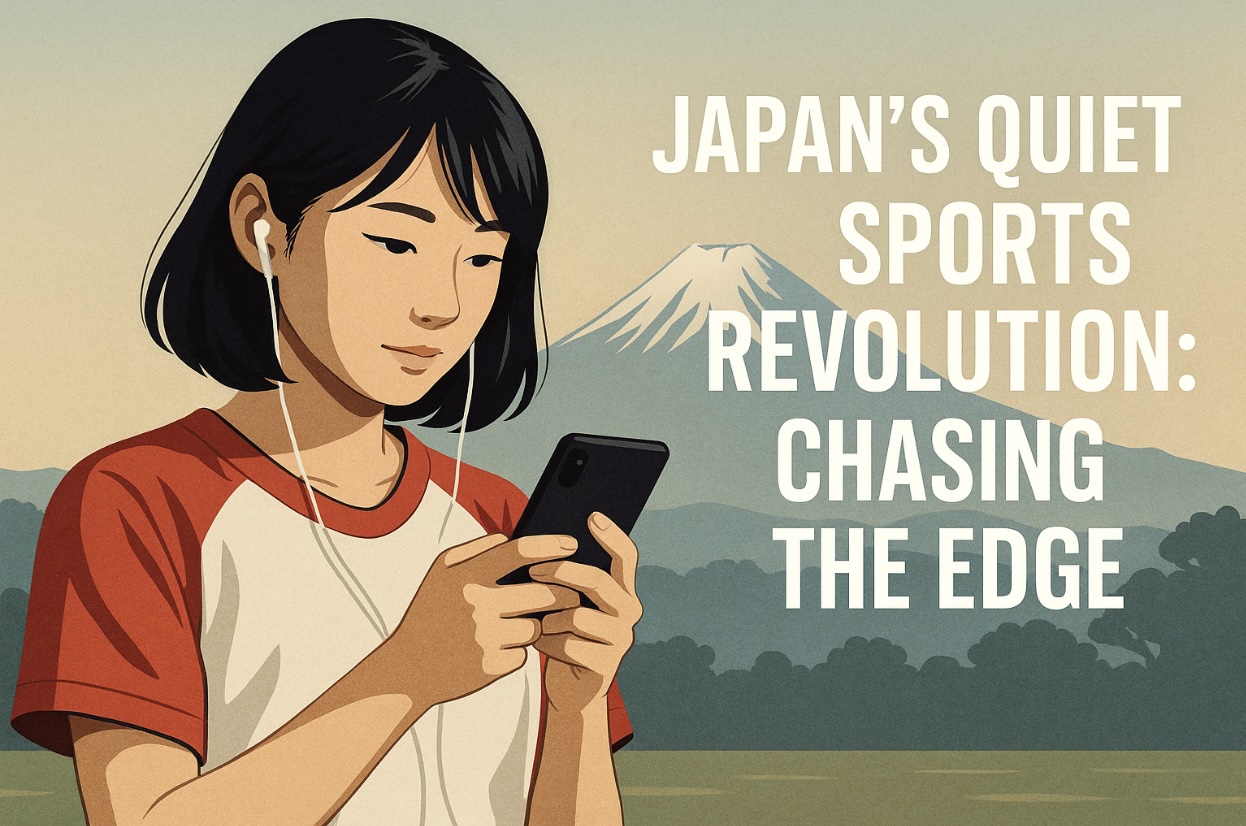Oct 15 (News On Japan) - There’s a new story unfolding in Japanese sports -- one that you won’t always see in the headlines.

While tradition remains strong, a silent wave of innovation is sweeping through training facilities, stadiums, and even living rooms across the country.
Data-driven decisions, advanced analytics, and digital fan experiences are changing how athletes perform and how supporters follow their teams.
This article takes you behind the curtain to reveal what’s driving Japan’s subtle yet powerful transformation on the global sporting stage, and why this quiet revolution matters more than ever.
Betting websites: The data-driven frontier for Japanese sports fans
Japan’s appetite for sports analytics is quietly reshaping how fans connect with their favorite games and teams.
One of the clearest signs is the rise of Betting websites that deliver expert reviews, bookmaker comparisons, and data-backed tips tailored to Japanese preferences.
These platforms do more than just list odds. They offer deep dives into team stats, historical trends, and up-to-the-minute injury updates—making it easier for even casual fans to make smarter choices about where to place a wager.
For many users in Japan, the blend of trusted local insight and global analytics has made betting websites a daily destination, especially around big events like Nippon Professional Baseball games or international soccer matches.
The appeal goes beyond numbers. There’s a growing social element as well—fans swap predictions, share strategies on forums, and build communities centered around thoughtful analysis rather than pure luck.
This digital shift mirrors Japan’s broader approach: combining respect for sporting tradition with a hunger for innovation. As more fans seek an edge through data, these sites are shaping how the next generation experiences both the thrill of sport and the fun of strategic betting.
Analytics and innovation: how Japan is redefining performance
Japan’s approach to sports performance is entering a new era, driven by an intense focus on analytics and modern technology.
In Olympic training centers, pro leagues, and even youth programs, data now shapes everything from nutrition plans to real-time tactical decisions.
This shift isn’t just about numbers on a screen. It’s about using insights to personalize training, spot emerging talent, and push the boundaries of what Japanese athletes can achieve.
Coaches and athletes are embracing these tools not for show, but as a quiet weapon in their pursuit of global results.
Smart training: from wearables to AI coaching
The old image of relentless drills has given way to smarter routines powered by wearables and AI feedback.
Japanese athletes across baseball, soccer, and martial arts are using motion sensors and video analysis that deliver instant feedback on every movement.
This isn’t limited to elite teams. Even high school coaches now experiment with apps that break down biomechanics or recommend recovery tweaks based on sleep data.
A 2024 industry report highlights how Japanese teams increasingly rely on AI-powered performance tracking and wearables. These tools let coaches make adjustments during practice—sometimes mid-drill—fine-tuning technique before minor flaws become habits.
I’ve seen baseball academies in Tokyo use sensor-laden bats for swing analysis. One thing that stands out: young players get corrections in real time, which accelerates progress without risking overuse injuries.
This blend of tradition with new tech is quickly becoming Japan’s signature approach to competitive sports.
Injury prevention and longevity
No matter how advanced the technology gets, injuries remain a stubborn challenge—especially among college-level athletes chasing pro dreams.
The good news is that data analytics are changing how teams monitor player workload. Now it’s common for strength coaches to review weekly dashboards flagging fatigue risks before they lead to muscle strains or worse.
A 2023 study found injury rates are still high among Japanese collegiate athletes. That’s fueling the adoption of systems that analyze movement patterns, track training loads, and suggest adjustments—like an extra rest day or lighter session after spikes in intensity.
This isn’t only about keeping stars healthy for the next match. By using data to spot early warning signs, teams help top performers extend their careers well beyond what was possible a decade ago.
There’s a sense here that if Japan can keep its best athletes on the field longer—and keep them evolving—it gives the country a subtle but lasting edge in international sport.
The evolving fan experience in Japan
Japanese sports fans aren’t just cheering from the sidelines anymore. In 2025, technology is giving supporters more ways to connect with teams, events, and each other—both inside the stadium and at home.
Interactive apps and immersive displays have turned match days into experiences that go beyond what’s happening on the field. Fans can now track their favorite players’ stats in real time or use augmented reality to bring team mascots into their living rooms.
This digital transformation has created a sense of community and engagement that feels uniquely modern but still honors Japan’s tradition of collective spirit and support. The result is a new style of fandom—more informed, more interactive, and much more fun.
Second screens and real-time stats
Gone are the days when watching a game meant staring at a single TV broadcast. Today’s Japanese fans split their attention across mobile devices, live stat feeds, and even AR overlays inside stadiums.
Mobile apps deliver instant play-by-play updates, heatmaps of player movement, and advanced analytics previously reserved for coaches. I’ve watched fans in Tokyo Dome compare pitch speeds or debate coaching decisions in real time—all thanks to data popping up on their phones mid-inning.
Augmented reality is making waves too. Some venues project instant replays or interactive graphics onto seat backs, while others let you scan QR codes for exclusive content. It’s not just entertainment—it helps casual viewers understand the nuances that make each sport unique in Japan.
Community, social media, and fantasy leagues
The digital boom hasn’t just changed how Japanese fans consume sports—it’s transformed how they connect with one another.
Online communities are buzzing on platforms like X (formerly Twitter), LINE groups, and even Discord servers dedicated to NPB baseball or J-League soccer. Heated debates over lineups mix with meme-sharing and live reactions as matches unfold.
Fantasy sports have taken off as well. Recent reports show that digital connectivity, social media, and media partnerships are fueling the rapid growth of Japan's fantasy sports market, offering more ways for fans to engage and participate in their favorite sports communities. It’s now common for friends to draft virtual teams before big tournaments—injecting strategy (and bragging rights) into every matchday.
This fusion of online connection and real-world excitement gives Japanese fandom a fresh edge without sacrificing its signature sense of belonging.
Future frontiers technology tradition and the Japanese edge
Japan’s quiet sports revolution is only gaining momentum, with each season bringing a fresh mix of breakthrough tools and deeply rooted customs.
The next phase isn’t just about sharper stats or more sensors—it’s about how technology can elevate what’s already special about Japanese sport.
From the rise of predictive analytics to renewed focus on community and respect, Japan is walking a distinctive path that’s as much about heart as hardware.
AI big data and the next generation of athletes
Machine learning isn’t just a buzzword in Japan’s training centers—it's now embedded in how coaches spot talent, build teams, and map out winning strategies.
I’ve seen youth academies tap into real-time data to personalize workouts for every player. It’s making athlete development faster, smarter, and more responsive than ever before.
A 2023 Asia-Pacific review highlights how Japanese sports bodies are using AI for talent selection and strategic planning, helping shape the next generation of athletes through smarter use of analytics. This blend of tech and intuition gives teams an edge from grassroots to elite levels.
Balancing innovation with heritage
Pushing boundaries doesn’t mean losing sight of what matters most. In Japan, sports culture still celebrates discipline, humility, and connection—even as new tech reshapes competition.
Leaders in sumo wrestling, baseball, and even e-sports are finding ways to blend digital progress with age-old rituals. You’ll see stadiums decked out with sensors one moment and a bow of mutual respect the next.
A 2023 feature explores how Japan’s sports scene manages tradition and innovation side by side, ensuring that new technology is harmoniously integrated without losing the cultural values that define Japanese sportsmanship. This balance could be what keeps Japan ahead—fusing progress with purpose in every match.
Conclusion
Japan’s transformation in the sports world doesn’t shout for attention, but its influence is clear if you look closely.
Innovation through analytics, smart technology, and new digital platforms is quietly changing how Japanese athletes train, recover, and perform.
At the same time, a deep respect for heritage and community keeps the heart of Japanese sport grounded.
This careful blend of forward-thinking and tradition could be Japan’s secret weapon as it continues to make its mark on the global stage—one precise step at a time.















